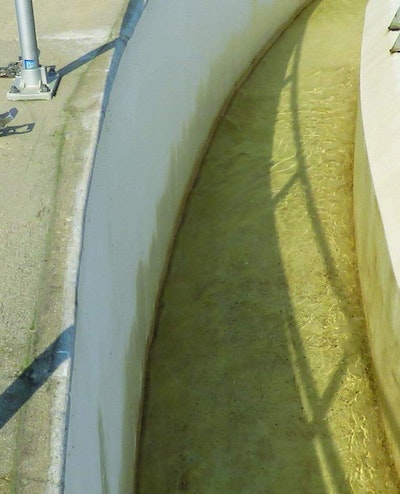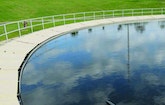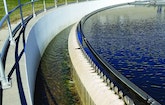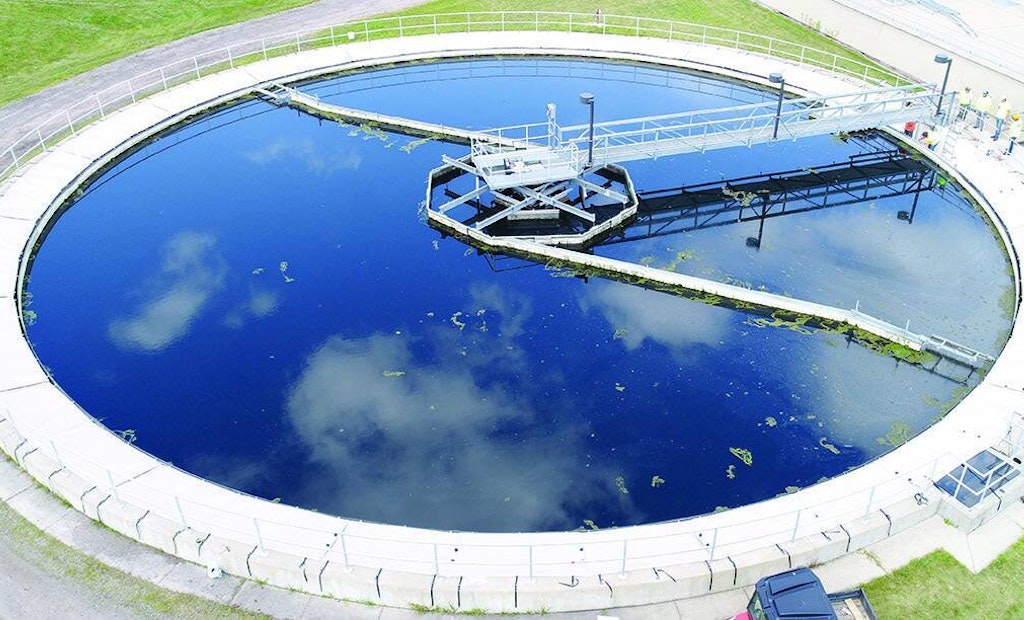Interested in Maintenance?
Get Maintenance articles, news and videos right in your inbox! Sign up now.
Maintenance + Get AlertsEvery kid wants a pet fish in the bedroom — until it’s time to scrub off the algae that grows on the tank where sunlight meets the nutrient-rich water.
A 120-foot-diameter clarifier at the Rochester (Minnesota) Water Reclamation Plant had a similar (though much larger) problem of its own, in the launder and weir area of a final clarifier.
Since the facility’s construction, the fifth and final clarifier had algae cultivation issues, and not for lack of effort and maintenance. “We were cleaning the weir on a weekly basis, and it took multiple people about half a day or more each time,” says Corey Bjornberg, process control engineer.
The battle was constant. “If we let the algae grow, we get long strands that eventually slough off and can potentially clog our sampling equipment,” says Bjornberg. “It can even be sampled, resulting in an effluent TSS or total phosphorus level that is artificially high due to a single strand of algae.”
There was another reason to keep the clarifier algae-free: the plant hosts numerous public tours, and so sustaining a spotless launder area was critical to keeping the plant showroom ready. “Rochester has always taken pride in a well-maintained and clean facility,” Bjornberg says. “This is important not only for our public tours, but also our own staff to have a clean facility they can be proud of.”
Fortunately, the plant team found a launder cover that fit the budget while providing effective algae control.
Neighborly solution
It took a trip from Rochester to a trade show in New Orleans for Bjornberg to find Industrial & Environmental Concepts, a company that had just come out with the Flexible Launder Cover. Says Dave Anderson, technical sales representative for IEC, “Corey told us they had algae issues and needed covers. We found out where he was located, and our facility in Lakewood is only about an hour and a half from their plant.”
IEC received specifications for the plant’s clarifier and entered them into a computer program to digitally design the cover before going on site. Once the design was complete, the IEC team got to work setting the mounting brackets.
Brian Cain, project manager for IEC, handled most of the installation, but since this was the first install and close to home, he had a lot of help. “We had a handful of our experienced fieldworkers there and both owners of the company,” Cain says. “I think just about everyone from the company stopped out there at some point to see the install.”
Now for installations, IEC provides an adviser, and customers are required to provide the rest of the workforce, whether their own technicians or contractors. “With an IEC adviser and about three good workers with mechanical skills, we can get most projects done in about two days,” Cain says.
Rochester was a good test for the launder cover material, as the plant experiences wind, snow and other adverse weather. “The material is an XR-5 geomembrane from Seaman Corporation,” Cain says. “It’s designed for exposure to wastewater and to the elements like UV light and cold weather.”
Along with the industrial membrane, the launder covers use stainless steel hardware and reinforced high-density polyethylene to provide a framework and support. They can be made to fit both rectangular and round clarifiers.
Mike Lever, business development, technical sales and marketing specialist for IEC, says those materials are nothing new for the company, which has confidence in their integrity. “Most launder covers are fiberglass or aluminum and are quite effective,” Lever says. “But the XR-5 geomembrane material gives municipalities that may be on more of a budget a comparable and effective solution.”
Algae-free
The cover was installed in 2019, and the plant operators did not open or remove it for one year. During that time, they had no issues with algae causing clogging or creating downstream maintenance.
In August 2020, they took a closer look at what was happening underneath. The cover took about four hours to fully remove; they found no algae was growing under it. The only growth they observed was a thin layer of biofilm on the launder floor and walls, which they expected.
After reinstallation, they decided to leave the cover in place for at least two years before removing it to clean again. When they did so in summer of 2022, they observed the same conditions as in 2020. The Flexible Launder Cover reduced cleaning of the clarifier launder and weirs from once per week to once per two years.
“During the summer months it would take three to four staff members half a day to clean every week, so it was labor intensive,” Bjornberg says. “It wasn’t as bad in winter, but it still took quite a few labor hours to keep it clean. Considering those labor costs, we save over $10,000 per year.”
Besides saving time and money, the cover keeps out dust, dirt and debris, improving the overall aesthetics of the plant. “It helps maintain the clean look we desire,” says Bjornberg.
After almost four years of experience with the cover, Bjornberg has no qualms with the product. “The cover has held up extremely well to date,” he says. “We have not replaced any components since installation.”









